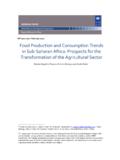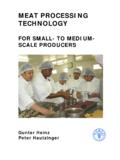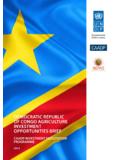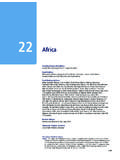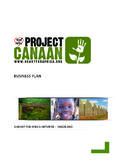Transcription of REGIONAL ANALYSIS CONTRIBUTIONS OF EASTERN AFRICA
1 67 WORKING PAPERENVIRONMENT AND NATURAL RESOURCES MANAGEMENTGaps and opportunities in the agriculture sectorsREGIONAL ANALYSIS OF THE NATIONALLY DETERMINED CONTRIBUTIONS OF EASTERN AFRICAREGIONAL ANALYSIS OF THE NATIONALLY DETERMINED CONTRIBUTIONS OF EASTERN AFRICA NDCFAO 2017 food AND agriculture ORGANIZATION OF THE UNITED NATIONSRome, 2017 REGIONAL ANALYSIS OF THE NATIONALLY DETERMINED CONTRIBUTIONS OF EASTERN AFRICAGaps and opportunities in the agriculture sectorsMitigation Authors Krystal Crumpler, Elizabeth Laval, Sandro Federici, Florent Eveille, Martial Bernoux and Mirella SalvatoreAdaptation Authors Elisa Di Stefano, Maryline Darmaun, Ana Heureux, Selvaraju Ramasamy and Julia Wolf67 WORKING PAPERENVIRONMENT AND NATURAL RESOURCES MANAGEMENTNDCiiThe designations employed and the presentation of material in this information product do not imply the expression of any opinion whatsoever on the part of the food and agriculture Organization of the United Nations (FAO) concerning the legal or development status of any country, territory, city or area or of its authorities, or concerning the delimitation of its frontiers or boundaries.
2 The mention of specific companies or products of manufacturers, whether or not these have been patented, does not imply that these have been endorsed or recommended by FAO in preference to others of a similar nature that are not views expressed in this information product are those of the author(s) and do not necessarily reflect the views or policies of 978-92-5-130030-5 FAO, 2017 FAO encourages the use, reproduction and dissemination of material in this information product. Except where otherwise indicated, material may be copied, downloaded and printed for private study, research and teaching purposes, or for use in non-commercial products or services, provided that appropriate acknowledgement of FAO as the source and copyright holder is given and that FAO s endorsement of users views, products or services is not implied in any requests for translation and adaptation rights, and for resale and other commercial use rights should be made via w w or addressed to information products are available on the FAO website ( )
3 And can be purchased through viiAbbreviations and acronyms ixExecutive summary REGIONAL circumstances Overall coverage of mitigation and adaption in the NDCs Mitigation in the agriculture sectors Targets, policies and measures REGIONAL baseline net emission and mitigation target ANALYSIS Identifying gaps and opportunities to enhance mitigation ambitions Adaptation in the agriculture sectors Priority actions and cross-sectoral measures Identifying gaps and opportunities to enhance adaptation ambitions Synergies Priority areas for scaling up international support Conclusion xxviIntroduction 1 Background 1 Objective 1 Methodology 2 PART 1 REGIONAL circumstances Climate and natural resources Farming systems Population and rural economy food security and nutrition GHG emissions profile 9ivPART 2 REGIONAL mitigation and adaptation CONTRIBUTIONS in the agriculture sectors Mitigation contribution Economy-wide mitigation contribution Mitigation contribution in the agriculture sectors
4 Policies and measures in the agriculture sectors Adaptation contribution Climate-related hazards, impacts and associated vulnerabilities in the agriculture sectors Adaptation goals, policies and plans Adaptation priorities and actions in the agriculture sectors 28 PART 3 Gaps and opportunities in the agriculture sectors Mitigation ANALYSIS Baseline net emissions and mitigation targets Gap ANALYSIS Identifying opportunities to enhance REGIONAL mitigation ambitions Adaptation ANALYSIS Relevance of adaptation CONTRIBUTIONS to the REGIONAL context Coverage of adaptation priorities and actions in the agriculture sectors Coverage of cross-sectoral adaptation measures Reconciling synergies and trade offs between mitigation and adaptation Towards implementation: priority areas for international support Review of support needs Areas of intervention for scaling up support Conclusion 69 References 70 Annexes 75vTABLES, FIGURES & BOXESTABLES1.
5 Cumulated net reduction FROM GHG sectoral targets in the agriculture and LULUCF sectors 172. Climate-related hazards and risks 263. Observed and projected Climate Change impacts and vulnerable sectors 284. Synergistic potential of NDC priorities and relative cost 64 FIGURES1. REGIONAL GHG net emissions, per sector xii2. Share of REGIONAL GHG emissions amongst sources in the AFOLU sector xii3. Overview of the NDCs in the agriculture sectors of EASTERN AFRICA xiv4. Coverage of mitigation contribution in the agriculture sector xv5. Coverage of mitigation contribution in the LULUCF sector xvi6. Countries with policies and measures in the AFOLU sector, per activity/land use management xvi7. Share of countries with policies and measures on energy production and use from agricultural/forest biomass xvii8. Baseline value (2030) and NDC mitigation target (2030), compared with historical emissions (2015), in the agriculture sector for EASTERN AFRICA xviii9.
6 Baseline value (2030) and NDC mitigation target (2030), compared with historical net emissions (2015), in the LULUCF sector for EASTERN AFRICA xix10. Gaps in the overall coverage of policies and measures addressing REGIONAL GHG hotspots and opportunities for enhancing ambitions xxi11. Enhanced mitigation potential and cost in the agriculture sectors, 2016-2030 xxi12. Coverage of the ongoing and planned adaptation measures in the agriculture sectors xxiii13. Gaps in the overall coverage of adaptation actions addressing REGIONAL hazards and vulnerabilities, and opportunities for enhancing ambitions xxiv14. National planning for NDC implementation xxv15. Major farming systems in EASTERN AFRICA , SHARE of total area 716. Major farming systems, per broad category 717. Distribution of cattle stock, per major farming system 718.
7 REGIONAL GHG net emissions, per sector 1019. Share of REGIONAL emissions amongst sources in the AFOLU sector 1020. National emissions amongst source categories in the agriculture sector 1121. National emissions and removals from the LULUCF sector 1222. Coverage of economy-wide mitigation contribution 1623. Sectors covered in overall mitigation contribution 1624. Coverage of mitigation contribution in the agriculture sector 1825. Coverage of mitigation contribution in the LULUCF sector 1826. Countries with policies and measures in the agriculture sector, per management activity 1927. Share of countries with policies and measures on energy production from agricultural biomass, by fuel type 2128. Number of countries with policies and measures in the LULUCF sector, per land use management 2329. Share of countries with policies and measures on energy production and use from forest biomass 2430.
8 Main ongoing and planned adaptation actions for the crop sector 3031. Adaptation actions in the livestock sector 3032. Main ongoing and planned adaptation actions for the water resource management 3133. Main ongoing and planned adaptation actions for management of forests 3334. Main ongoing and planned adaptation actions for management of the land and other ecosystems 3335. Main ongoing and planned adaptation actions for the management of fisheries, coastal zones and marine ecosystems 3436. Main ongoing and planned DDR/DRM actions 36vi37. Economy-wide baseline value (2030) and NDC mitigation target (2030) in 2030, compared with historical net emissions (2015), in EASTERN AFRICA 4238. Baseline value (2030) and NDC mitigation target (2030), compared with historical emissions (2015), in the agriculture sector for EASTERN AFRICA 4339.
9 Baseline value (2030) and NDC mitigation target (2030), compared with historical net emissions (2015), in the LULUCF sector for EASTERN AFRICA 4440. GHG Hotspots in the AFOLU sector 4541. Gaps in the overall coverage of policies and measures addressing REGIONAL GHG hotspots 4642. Enhanced mitigation potential and cost in the agriculture sectors, 2016-2030 4843. Growth in cereal production (2005 2014) 5144. Ratio of actual to potential yield in rainfed maize farming systems 5145. Cattle density per farming system 5246. Farming systems associated with savannah burning emissions 5647. Burning savannah GHG intensity per farming system 5748. mapping synergies between mitigation and adaptation in the ndcs 6349. Financial condition of NDC implementation 6650. Share of total finance needs for NDC implementation 6651. IPCC Guidelines used for National Greenhouse Gas Inventory 6752.
10 Mitigation and adaptation reporting systems in place 6753. National planning for NDC implementation 68 BOXES1. Box 1: Energy from agriculture 212. Box 2: Energy from forests 233. BOX 3: Unlocking the mitigation potential of EASTERN AFRICA : An alternative to biomass burning 56viiACKNOWLEDGEMENTSThe NDC REGIONAL ANALYSIS was prepared under the overall leadership of Martial Bernoux (Natural Resource Officer, CBC) and Julia Wolf (Natural Resource Officer, CBC).The management of the NDC database, ANALYSIS and writing relative to the mitigation component was led by Krystal Crumpler (CBC), Elizabeth Laval (CBC), Sandro Federici (CBC), Florent Eveille (CBC) and Mirella Salvatore (CBC), while the adaptation component was led by Elisa Di Stefano (CBC), Maryline Darmaun (CBC), Ana Heureux (CBC) and Selvaraju Ramasamy (CBC).The authors are especially grateful for the valuable input and guidance provided by Alexandre Meybeck (AGDD).











